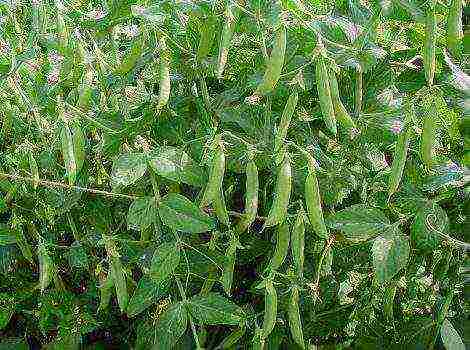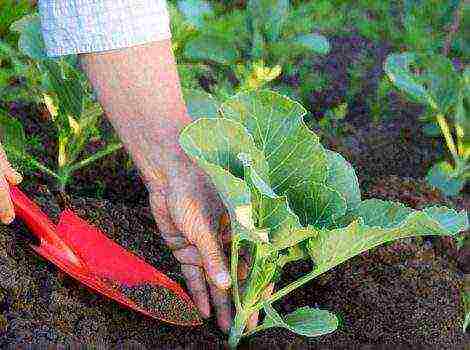Content
When feeding tomatoes, care must be taken not to overfeed them with too much nitrogen, otherwise the seedlings will become "fatty" and will not form fruit. In order to feed tomatoes, various types can be used: when grown in a greenhouse, open ground, yeast, so that the seedlings are plump, which must be placed after planting and in the hole when digging up the ground for tomatoes.
The first feeding of seedlings
15 days after sowing seeds, when the first shoots begin to appear, add 1 teaspoon of nitrophoska and 1 teaspoon of nitroammophoska in 1 liter of water and water the seedlings.
How to fertilize in the future at home
Count down 25 days after sowing seeds. Pour in 1 liter of water a little less than a teaspoon of nitrophosphate and a little less than a teaspoon of potassium permanganate, and another half of a teaspoon of nitroammophoska. Water the seedlings.
Feeding after a dive
2 weeks after the pick, add 1 tbsp. spoon potassium sulfate and 1 tbsp. a spoonful of granular superphosphate in a ten-liter bucket of water. Water the seedlings.
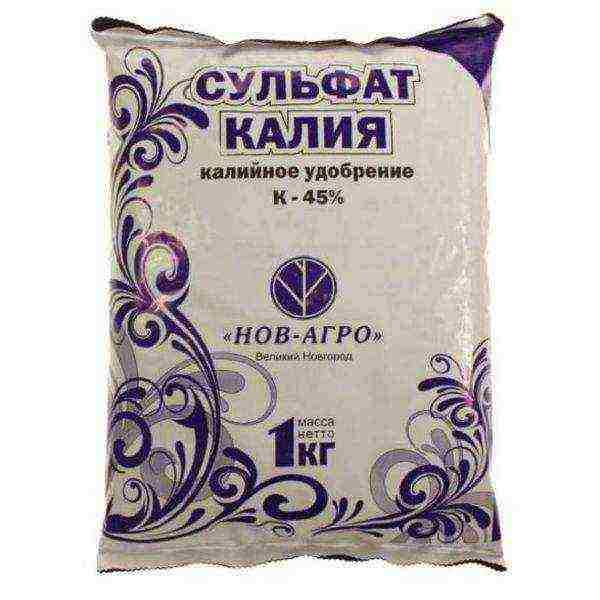
How to feed for growth
Mix 2 parts bird droppings with 1 part of water, cover the container with a lid, Leave for 2-3 days. Then dilute the infusion with water in a ratio of 1:10.
Types of tomato additives
Mineral fertilizers
Top dressing is of 2 types:
- Organic - these are the compounds that plants need, they are formed from the decomposition of plants and from the waste products of animals.
- Mineral —– they are made without using organics.
Mineral feeding of tomatoes can be of 2 types: simple (they include 1 component), complex (they contain 2, 3 or more components). Simple mineral dressings for tomatoes are those that consist of any one macronutrient or micronutrient.
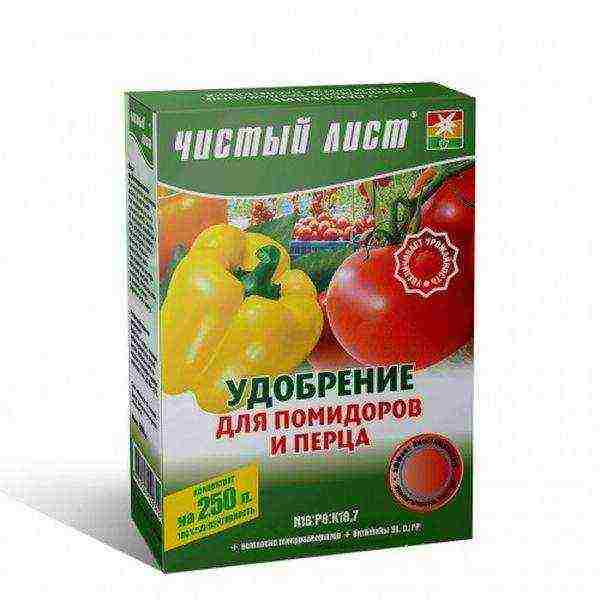
Macronutrient is nitrogen or phosphorus, potassium. And trace elements are substances that are required for the normal growth of tomato bushes - magnesium, calcium, zinc, etc.
- Magnesium improves the intensity of photosynthesis and promotes the formation of chlorophyll. With its deficiency, chlorosis is visible on the leaves, that is, they turn yellow. Magnesium nitrate is used, they are sprayed with bushes, dissolving 5 g of the substance in a ten-liter bucket of water.
- Zinc promotes protein, carbohydrate, phosphorus metabolism in plants. With its lack, grayish-bronze specks appear on the leaves. For feeding, they take zinc sulfate, they are sprayed with plants, diluting 5 g in a ten-liter bucket of water.
- Calcium - use calcium nitrate, spraying tomatoes, pouring 5 g in 10 liters of water.
- Molybdenum improves phosphorus, nitrogen and carbohydrate metabolism. With a lack of molybdenum, the very first true leaves turn yellow, their edges curl. Those leaves that grow back become speckled. They buy ammonium molybdate, add 2 g to 10 liters of water, pour the solution under the roots, trying not to get on the leaves.
- Sulfur - acquire magnesium sulfate, spray the bushes, pouring 10 g into 10 liters of water.
- Boron - tomato flowers are sprayed with boric acid solution so that they tie, 5 g is taken for 10 liters of water.
- Manganese - with a deficiency of the element, yellowing of the leaf plate is visible against the background of dark green veins. They buy manganese sulfate, spray the bushes, dissolving 5 g in 10 liters of water.
- Copper - use copper sulfate, making a solution of 2 g of the substance and a ten-liter bucket of water.
- Iron, with a deficiency of the element, the bases of the leaves turn yellow. Take ferrous sulfate, diluting 5 g in 10 liters of water.
- Chlorine - is used quite rarely, since the substance inhibits the bushes. There is a lot of chlorine in saline soils, but not enough in leached soils. The chlorine limit in the soil of tomato greenhouses is 0.02% on air-dry soil. With a lack of chlorine, chlorosis appears on young leaves, they wither. With a greater chlorine deficiency, the leaves become bronze. The bushes are sprayed with potassium chloride, diluting 5 g in 10 liters of water.

Phosphoric
- Monophosphate (simple superphosphate) is a grayish powder, it loses somewhat in efficiency to new fertilizers, but since it is cheap, it is used quite often.
- Granular superphosphate... It is made from monophosphate, moisturized and rolled into granules.
- Double... It contains calcium monophosphate, which is highly soluble in water. When feeding tomatoes, it is applied in half as much as simple superphosphate.
-
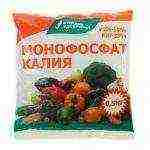
- Monophosphate
-

- Granular superphosphate
Potash
Potassium tomatoes consume a little, especially he necessary for fruiting, and potassium is also required at the stage of seedling growth in order to form strong, and not thin stems. Potassium promotes the formation of carbohydrates, increases the plant's immunity to diseases, frost, and heat.
The plant becomes stronger, the taste of tomatoes improves, the roots grow more intensively. As the stems harden, the tops become thick and do not lodge. If the plants do not have enough potassium, then the young leaves become curly if they are not strengthened in time and fertilizer is not applied.
Use potash fertilizers - potassium chloride and potassium sulfate (it is used more often, since there is no chlorine in it, and an excess of chlorine inhibits the bushes). When feeding tomatoes, 40 g of potassium sulfate per 1 m2 are poured into the ground. Top dressing increases the number of tomatoes that grow on the bushes and protects the plants from wilting.

Nitrogen
Nitrogen contributes intensive growth of greenery by the bushes. If the lower leaves of the seedlings turn yellow and fall off, this is due to a lack of nitrogen. It is best to use nitrogen if the seedlings have elongated, pale and thin stems.
Nitrogen is also required for the formation of a larger number of ovaries. Because of this, nitrogen is introduced twice a season - a week after planting the seedlings and at the beginning of the formation of ovaries.
In August, nitrogen is no longer worth using, since the bushes do not need to build up the green mass, but throw all their strength into pouring the fruits. Mineral fertilizers with nitrogen content - ammonium sulfate, carbamide, ammonium nitrate... But do not forget that fertilizing with nitrogen makes the soil more acidic, so you need to add lime with them.
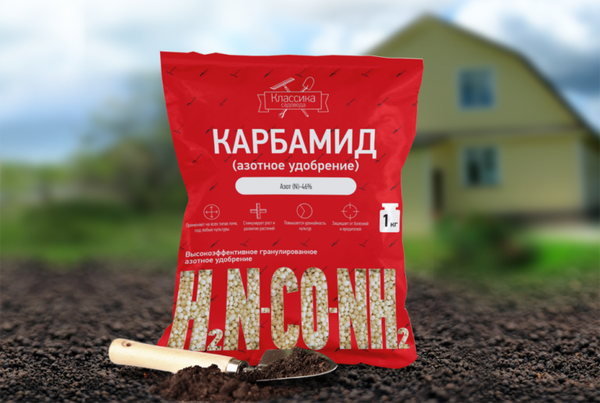
Complex
Ammophos
-
- , it contains nitrogen and phosphorus, is sold in the form of granules. The advantage of this fertilizer is the absence of nitrates and chlorine. They are used both when digging the ground before planting, and when feeding the bushes.
Ammofoska, it contains nitrogen, phosphorus, potassium, and also trace elements - potassium, sulfur, magnesium. Fertilizer increases the resistance of tomatoes to diseases and with its help the bushes grow fully.
Diammofoska - in addition to nitrogen, phosphorus, potassium, it contains 8 more microelements, including zinc, iron, manganese.Very suitable for greenhouses.
Nitroammofoska - These are granules consisting of nitrogen, sulfur, phosphorus, potassium.
Nitrophoska, contains all 3 macronutrients necessary for tomato care: nitrogen, phosphorus, potassium. Suitable for all types of land, stimulates the growth and development of plants.

Folk remedies
Folk remedies in most cases are also suitable for other vegetables - peppers, cucumbers. You need to add and put fertilizers in the amount indicated in the description.
Iodine
Place 4 drops of alcohol-infused iodine in a ten-liter bucket of water. Fertilize with 2 liters of liquid per bush.
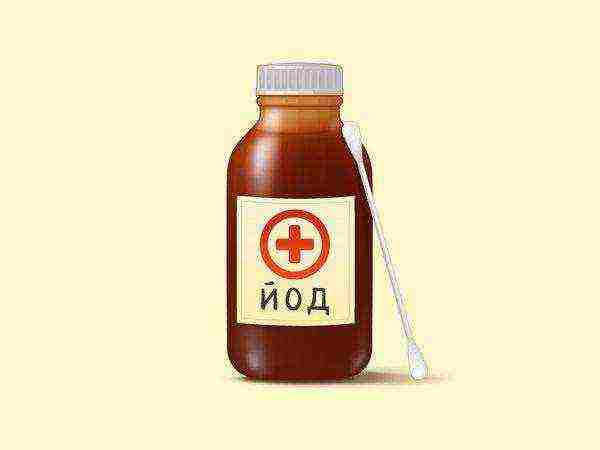
Ash
Wood ash contains large amounts of potassium and phosphorus... For feeding, pour 1 glass of folk remedy into a ten-liter bucket of water, and then pour it under the roots of each bush.
You can do foliar top dressing with ash. To cook it, pour 300 g of ash in 3 liters of water and boil for half an hour. Then leave it on for 5 hours. Then pour in another 7 liters of water. Add a little grated laundry soap to the composition, then it will stick to the leaves. Next, strain the solution and spray the leaves and stems with it.
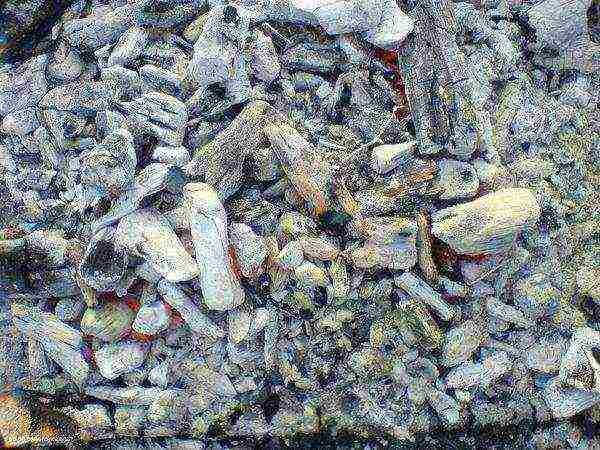
Banana peel
The banana peel contains a lot of potassium... Put the skins of 2-3 bananas in a 3 liter jar, top up with warm water. Leave for 3 days at home, strain and pour under the bushes. You need to water without getting on the leaves.
Eggshell
Finely crush the shells of 3-4 eggs, pour into a 3 liter jar, top up with warm water, cover with a lid and set in the dark for 3 days. When the composition becomes cloudy and smells unpleasant, you can use it for watering.
Organic fertilizers
Chicken droppings
To fertilize tomatoes, pour 1/3 of the bird droppings into a ten-liter bucket, add water to the top. It needs to be cooked and left on the street for 7-10 days. Next, dilute the infusion with another 200 liters of water. Pour the solution between the rows, pouring 5-6 liters per 1 m².
Make sure the chicken solution gets into under the roots, and not splashing on the leaves, as this may cause burns.
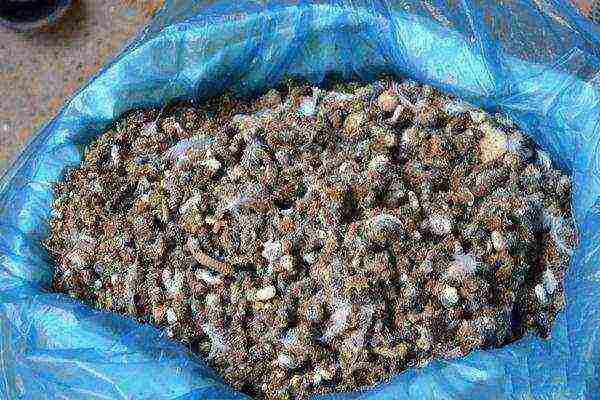
Manure
Take a ten-liter bucket, fill half a bucket with manure, for example, horse manure, add water, cover with a lid, leave for 7 days in a warm place. After the infusion, stir, add another 100 liters of water to get a weak solution. Pour half a liter under the bush.
What is green manure
Make an infusion of young nettle leaves, they have a huge amount of potassium, iron, nitrogen. Pour nettle into a container 2/3, add water, cover with a lid. Prepare and leave warm for 7-10 days to ferment the nettle. Next, dilute each liter of infusion with ten liters of water.
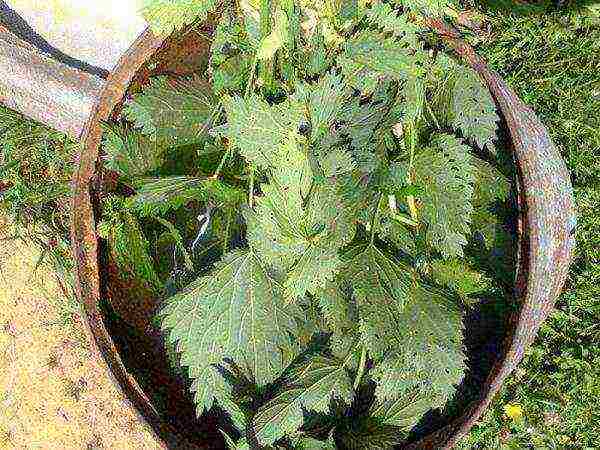
Pour 1 liter under the bush. You can replace the nettle with any fresh young herb, for example, dandelion, alfalfa. In a month, you can make 2 top dressing with infusion of green fertilizer.
Foliar feeding
Plants absorb nutrients from the soil through the roots, and nutrients are absorbed by plants through the leaves. Therefore, foliar feeding is so important, since through the leaves all the necessary substances penetrate the cells very quickly, they do not need time to dissolve in the ground. Foliar dressing is very effective for weakened seedlings.
In this way, the bushes are fed once a week or once every 6 days. Pour 10-15 g of carbamide, 15 g of potassium sulfate, 19 g of superphosphate into a ten-liter bucket of water. Spray the leaves and stems of the tomatoes with the solution.
Standard scheme for applying additives under bushes
Top dressing is done up to 6 times... Tomatoes are fertilized only early in the morning or late in the evening.
Top dressing of tomatoes in the open field
- If seedlings stunted, then 3-4 days after planting it, pour it with a solution of urea, dissolving 1 tbsp. spoon in a ten-liter bucket of water. Water the seedlings at the root.
- 21 days after transplanting seedlings into open ground, pour 0.5 liters of mullein and add 1 tbsp. spoon of urea in a ten-liter bucket of water. Water the bushes with the composition.
- When tomatoes bloom, then feed them potassium or ash. Dig holes along the beds, pour ash there, and then bury them. At the same time, pour a solution of bird droppings by dissolving half a liter in a ten-liter bucket of water.
- When whole brushes of flowers appear, feed the bushes with sodium humate. 2 weeks after feeding with humate, make a superphosphate solution. Pour a bucket of mortar over 1 m².
- Make 2 more dressings during the formation of fruits, use potassium and phosphorus.

In the greenhouse
- A week after planting tomato seedlings in a greenhouse or polycarbonate greenhouse in the spring, make a solution by adding 2 teaspoons of carbamide and 2 teaspoons of ammonium nitrate to a ten-liter bucket of water.
- 2 weeks after the first feeding, add potassium sulfate to 10 liters of water.
- Wait another 5 days and do 3 feeding from 2 tbsp. tablespoons of ash, 2 tbsp. tablespoons of superphosphate and 15 liters of water.
- When the bushes bloom, then spray them with the composition: add 2 teaspoons of sodium humate, 3 tbsp. tablespoons of nitrophoska in a ten-liter bucket of water. Pour 5 liters per 1 m².
- When vegetables start to pour, then feed under the root with potassium and phosphorus.
Fertilizers
For tomato and pepper seedlings
Pour 1-3 ml of iodine into a ten-liter bucket of water. Pour in 1 liter of milk or fermented kefir. Such a composition increases the amount of harvest and improves its quality.
Pour half a liter of solution under the roots of one bush. After watering with iodine solution, be sure to pour the bushes with clean, settled water at a temperature of 22 degrees.
Yeast
- Pour a bag of dry instant yeast and 2 tbsp. tablespoons of granulated sugar, mix, add a little water. After the mixture, pour into a ten-liter bucket of water. Pour half a liter of the composition onto the bush.
- Fill a 3-liter jar 2/3 with brown bread. Dissolve 100 g of yeast in water and add to the jar so that it is completely full. The bank should stand in a warm room for 3-5 days. Next, strain the composition through cheesecloth. Dilute the composition by pouring in another 30 liters of water. Pour half a liter of solution under a young bush, and 2 liters under an adult bush.
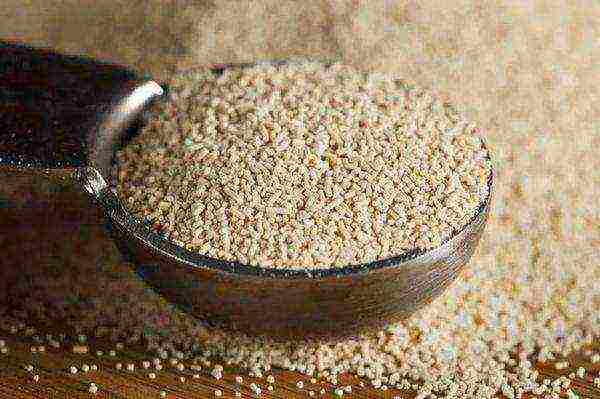
Yeast does not contain macro- and microelements, because of this, they only stimulate plant growth.
Seasonal per hole
When digging the earth, first scatter 1-2 buckets of compost per 1 m², and then dig up the earth.
Pour 1 tbsp into each hole before planting. spoonful of ash. And one more of the following fertilizers: 20 g of "Universal" fertilizer or 50 g of superphosphate. But you can instead pour 100 g of fertilizer into each well. Biohumus.
When digging holes for seedlings, they are made 20 cm deep, but the distance between them is left depending on which variety you are going to plant. For undersized varieties, indent 20-30 cm, and for tall 70-90 cm.
Top dressing with a variety of fertilizers helps to properly grow and develop the stems and leaves of tomatoes. They help to bloom more abundantly and promote the formation of more ovaries. When applying dressings, the fruits ripen faster, acquire a better taste.
